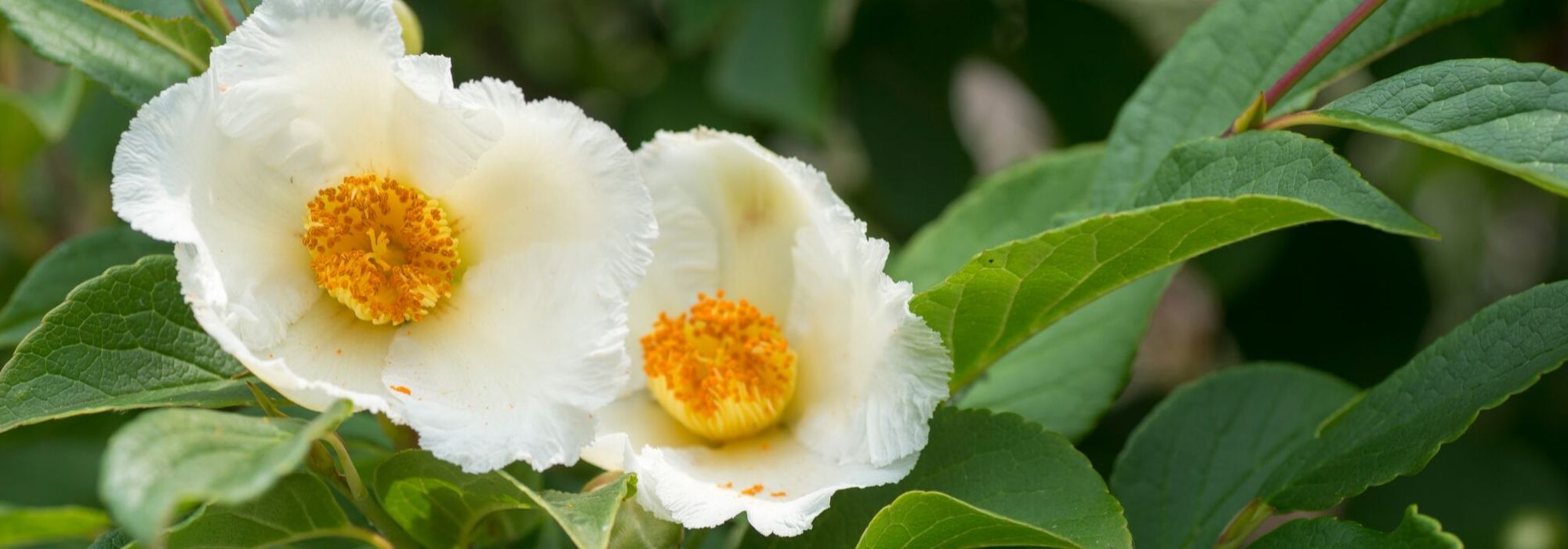
Stewartia pseudocamellia, False camellia: planting, pruning, care
Contents
Stewartia in a nutshell
- Stewartia is a small deciduous tree that produces pretty white or pale pink flowers, reminiscent of camellia, throughout summer
- It is also decorative for its fruits, its beautiful autumn colours and for its colourful bark in winter
- Very hardy and virtually disease-free, it is a part-shade bush that grows best in acidic soil
- Its graceful silhouette and moderate size allow many uses in all gardens, even modest-sized ones
- Slow-growing, it is used for informal hedging, in mixed borders, on woodland edge, as a specimen or in a pot
A word from our expert
Stewartia, also called “false camellia” is a bush with long summer flowering that remains too little known. Asian species such as stewartia pseudocamellia and its variety stewartia pseudocamellia ‘Koreana’, Stewartia rostrata, Stewartia monadelpha, well known to bonsai enthusiasts, and Stewartia sinensis offer large delicate white or pink flowers, decorative red fruits, splendid autumn colours and a very beautiful bark with pink or orange hues. It is a very handsome garden bush of interest throughout the year!
With good hardiness, it tolerates neutral to acidic soil, free of lime, cool yet well drained, and grows in light shade sheltered from cold winds.
Of slow growth but often long-lived, reaching a century, it suits modestly sized gardens and even permits container culture on a shaded terrace. It will be the perfect companion for ericaceous plants such as Rhododendrons, Azaleas, Camellias, Hydrangeas, Andromedas…
All the more reason to adopt Stewartia, that beautiful bush which deserves a place of honour in every garden!
Description and botany
Botanical data
- Latin name Stewartia
- Family Theaceae
- Common name Stuartia, false camellia
- Flowering June to August
- Height 2 to 8 m
- Exposure Sun, partial shade
- Soil type Heather soil (Acid), Neutral
- Hardiness -15-25°C
Stewartia or Stuartia is a small tree or large bush of family Theaceae, like tea and its better-known cousin, camellia, to which it is closely related. Genus includes about 80 species of trees and bushes native to wooded mountains or stream banks of Japan, South Korea, China and North America. American species such as Stewartia ovata are considered vulnerable or endangered and are uncommon in our latitudes.
Four main species are cultivated for ornamental use in gardens:
- Stewartia pseudocamellia, sometimes nicknamed Stewartia false-camellia, and its varieties such as stewartia pseudocamellia ‘Koreana’ with large flowers
- Stewartia rostrata, very hardy (down to -20°C)
- Stewartia monadelpha, favoured by bonsai enthusiasts for its regularly tiered silhouette
- Stewartia sinensis, prized for very attractive decorative bark
All flower in summer and are valued for autumn colours as well as for colourful bark in winter.
Slow to establish and slow-growing, it eventually forms a true small tree that will rarely exceed 5–6 m in our gardens, with a 3–5 m spread at maturity, whereas in native regions it can reach up to 15 m. It displays a fine, well-balanced branching from the base. Slowness of growth is matched by longevity; notable specimens of two to three hundred years’ age are recorded.

Stewartia sinensis – botanical illustration
Habit differs markedly according to species: conical and well-branched from low down, even columnar in Stewartia pseudocamellia; in a spreading pyramidal crown that becomes trailing with age in S. rostrata; erect and regular in Stewartia monadelpha. Crown generally rounds with time.
Stewartia is notable for its extremely decorative bark that peels away over the years. Smooth cinnamon-red bark exfoliates in fine plates from pink to grey-beige, orange to purplish-brown according to variety, very attractive in winter. Only Stewartia rostrata has fairly unremarkable bark.
In Stewartia, deciduous and elegant foliage remains attractive outside flowering period as leaves take on splendid autumn colours. These glossy, entire, obovate to elliptical, fairly leathery leaves are 3–10 cm long, with strongly marked veins and finely dentate margins. Silky and paler beneath, they are bright to dark green until late summer, more rarely variegated with cream in some cultivars, then turn shades from orange to scarlet and purple before falling late in autumn.
From May–June to August, Stewartia produces pretty floral buds that open into single, delicate flowers. They appear solitary in leaf axils and bloom all along the shoots. They open as silky, widely open cups 3–6 cm across, formed of five rounded pure-white petals, sometimes streaked with pale pink, edged by elongated or slightly twisted sepals in Stewartia rostrata. Flowers show a yellow or purplish centre with anthers yellow-orange or violet depending on variety. Their delicate form recalls wild rose or camellia flowers, hence nickname false camellia; “Pseudocamellia” in Latin also means “resembling camellia”. Sometimes petal margins are attractively fringed. Short lifespan of individual flowers is offset by abundance, as blooms overlap and succeed one another for nearly two months. While scent is absent, flowers add great elegance.
Plant in light shade, sheltered from cold winds, in preferably acid soil such as heather soil, not too calcareous, that stays cool even in summer.
Slow-growing, Stewartia suits gardens of all sizes and can be used in a flowering hedge, as a specimen, at woodland edge or in a shaded border.
Latin name honours John Stuart, botanist and British prime minister of the 18th century.
Main species and varieties
Most popular
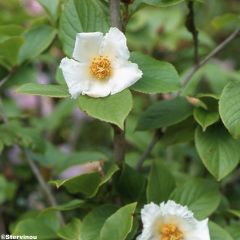
Stewartia pseudocamellia
- Flowering time August, September
- Height at maturity 4,50 m
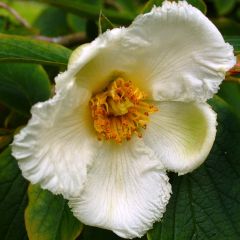
Stewartia pseudocamellia Koreana
- Flowering time July to September
- Height at maturity 6 m
Our favourites
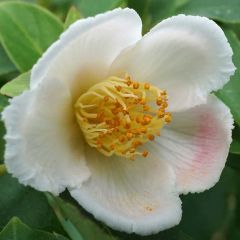
Stewartia rostrata
- Flowering time July
- Height at maturity 6 m
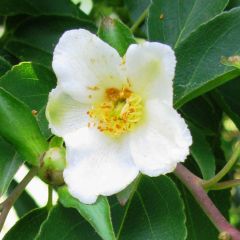
Stewartia monadelpha
- Flowering time July to September
- Height at maturity 6 m
Discover other Stewartia
View all →Available in 1 sizes
Available in 2 sizes
Available in 1 sizes
Available in 1 sizes
Planting
When to plant Stewartia?
Very hardy in open ground (−15°C to −25°C depending on species), Stewartia is fairly easy to acclimatise except perhaps in Mediterranean climate, too hot and dry in summer. In regions with long winters it is nonetheless advisable to give it a very sheltered spot because late frosts can compromise buds and young shoots, especially on young plants, which are more fragile.
Native to woodland understorey, it appreciates cool conditions and is best grown in partial shade, at a push in full sun if soil stays cool. It dislikes dense shade. As for soil, it is less demanding than its cousin Camellia, content with ordinary, neutral or slightly acidic soil, preferably fresh, light and humus-bearing, not too dry and without excess lime.
With slow growth and an unobtrusive habit, it suits modest-size gardens. Still allow enough space for it to spread freely, expect about 2 to 5 metres of spread. It does not tolerate transplanting well; so think carefully about placement before planting.
It will look magnificent both solitary in middle of a short grass meadow, in a small flowering hedge, or in a bush border, alongside other plants for non-calcareous soil (Magnolias, Rhododendron, azaleas, Hydrangea, Hamamelis, Pieris, Camellias, Kalmias, Japanese maples), or in a large pot on the terrace.
When to plant Stewartia?
Planting in spring, from March to April after the most severe frosts, will favour establishment.
How to plant Stewartia?
In open ground
If soil is too calcareous, improve it with an addition of heather soil. Provide a space 5 to 6 m wide. Once well established, avoid moving it, roots do not tolerate transplanting well.
- Dig a hole 3 times wider than rootball and 40 to 50 cm deep; the Stewartia should not be planted too deep
- Plant bush in a mix of compost and heather soil: top of rootball should be covered by 3 cm
- Keep tree upright
- Spread organic mulch of pine bark or dead leaves
- Water regularly during first 15 days after planting to keep soil cool
In a pot
Compact development of Stewartia makes this use perfectly possible. It tolerates pot culture very well in regions south of Loire; elsewhere potted specimens will be more sensitive to severe frosts. It will be happy in a large container (30 to 40 cm diameter) filled with a fresh, very free-draining mix, based on 1/3 heather soil, 1/3 potting compost and 1/3 garden soil not too calcareous, kept consistently moist because in a pot it will not tolerate drought even for short periods.
Place a layer of gravel or clay balls at bottom of container before planting.
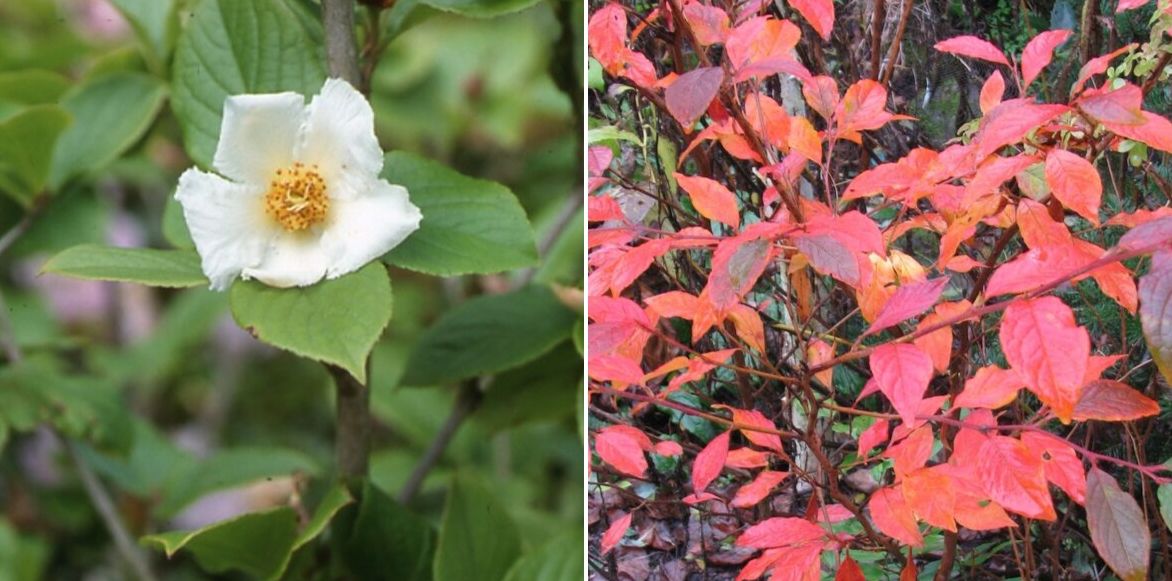
Stewartia pseudocamellia : flower and autumn foliage
Read also
10 bushes to grow in acidic soilMaintenance, pruning and care
In summer, monitor water needs during first year after planting for young Stewartia: water once a week and thoroughly in dry weather, the soil must never be dry; it dislikes drought and likes its roots to be kept cool during summer heat. Once well rooted, water only during periods of severe heat.
Apply an organic mulch (pine needles that will acidify the soil) to keep its roots cool in summer.
In winter, water occasionally if it does not rain.
In autumn, you can fertilise with a little compost, lightly forked into surface soil around the base.
In regions north of the Loire, protect the bush from severe frosts by covering the stump with a 5 to 7 cm thick mulch made of leaf mould and crushed bark. If late frosts are a concern, cover it with a winter fleece. Young specimens must be protected from severe frosts for at least 3 years.
Pruning is not necessary for Asian species; they do very well without intervention. However, it can be useful to clear the lower part of the trunk to showcase the bark in winter.
About every 3 years, after flowering, from February to April :
- Remove crossing branches and dead wood
- Lightly trim branch tips to rebalance the branches
When grown in good conditions, Stewartia shows little vulnerability to diseases and parasitic organisms. However, overly calcareous soil can cause chlorosis, resulting in yellowing of leaves and, in the long term, decline of the tree.
Propagation
Stewartia is quite difficult to propagate, sowing is possible but tedious and very slow (2–5 years to germinate), layering is always possible for branches closest to ground, but results are slow too and separation of a viable layer generally requires 2 years. We recommend stem cuttings in spring.
How to propagate?
Allow 1 year before complete rooting.
- In May–June, take 10 cm long shoots
- Remove all leaves from lower part
- With a small knife, strip bark over 2–3 cm
- Insert cuttings into well-draining mix of turf and perlite
- Place in shade, covered with plastic to retain humidity
- Keep cuttings moist by misting regularly
- During summer, repot cuttings into buckets
- Overwinter frost-free until following spring
- Plant in ground next spring
Pairing Stewartia in the garden
Still too little known, Stewartia is nevertheless a very handsome bush that fits easily into any garden provided it can be given a shady spot. Magnificent throughout summer with its profusion of large white rose‑like flowers, it is also indispensable for enlivening the garden in autumn when its foliage takes sumptuous colours and in winter with its colourful bark. As it dislikes lime‑rich soil, it pairs easily with ericaceous plants. It is the perfect choice for white gardens or romantic gardens, to which it brings great softness and freshness.
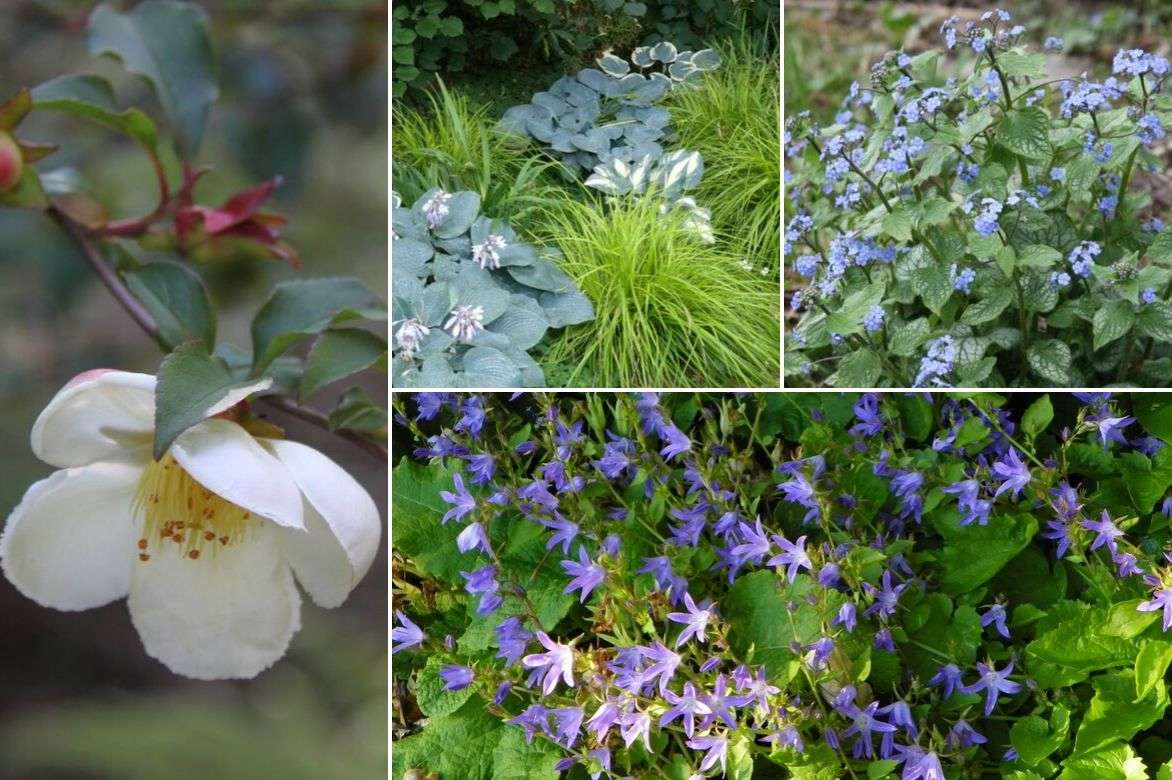
An example of a planting: Stewartia with, beneath its canopy, blue Hostas (‘Fragrant Blue’, ‘Halcyon’, or blue‑variegated (‘June’, ‘Frances Williams’, ‘El Niño’), Milium effusum ‘Aureum’, Brunnera macrophylla ‘Jack Frost’ or another variety, Campanula poscharskyana ‘Stella’ or the species
Its large white flowers bring good brightness and its glossy green foliage adds density to a large, slightly dull semi‑shaded border. Plant it at back of border mixed with acidophilous shade plants like it, such as small rhododendrons, ferns with finely dissected foliage and Hostas, which will provide an ideal contrast of form.
Against an evergreen backdrop of conifers and bushes with evergreen foliage, it will be magnificent alongside Calycanthus, Hamamelis and Fothergilla, bushes equally charming.
In summer, Stewartia also makes a fine grouped specimen at woodland edge. It will combine with bushes such as Andromèdes, Azalées, Kalmia, Camellias and Hydrangeas that will accompany its flowering.
In a flowering hedge, it will sit alongside a fine Cornus kousa, viburnums, Mexican orange blossom, spireas or Deutzia.
To ignite shady corners of garden in autumn, consider Acer, Chinese azaleas, Leucothoe, Nandina and tulip tree with their splendid autumn colours to accompany it.
For a garden with winter colour, and to showcase its decorative bark, why not plant it near the very distinctive Edgewortha chrysantha and Cornus with coloured wood such as Cornus alba ‘Bâton Rouge®’.
You can also dress base of this Asian tree with some Japanese primroses, a Magellan fuchsia or autumn bulbs such as white Naples cyclamens.
Useful resources
- Discover our range of Stewartia, available to order online
- Most beautiful summer-flowering bushes are with us, discover them!
- Here are 5 tips to successfully grow bushes in heather soil
- Subscribe!
- Contents
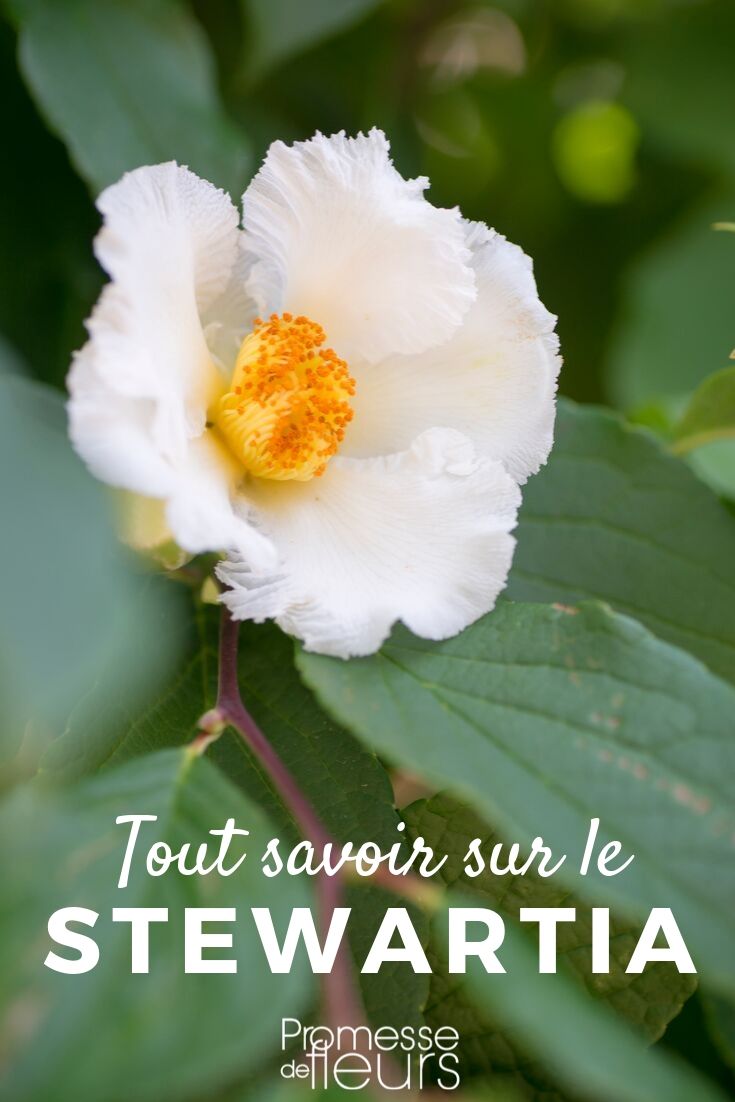






























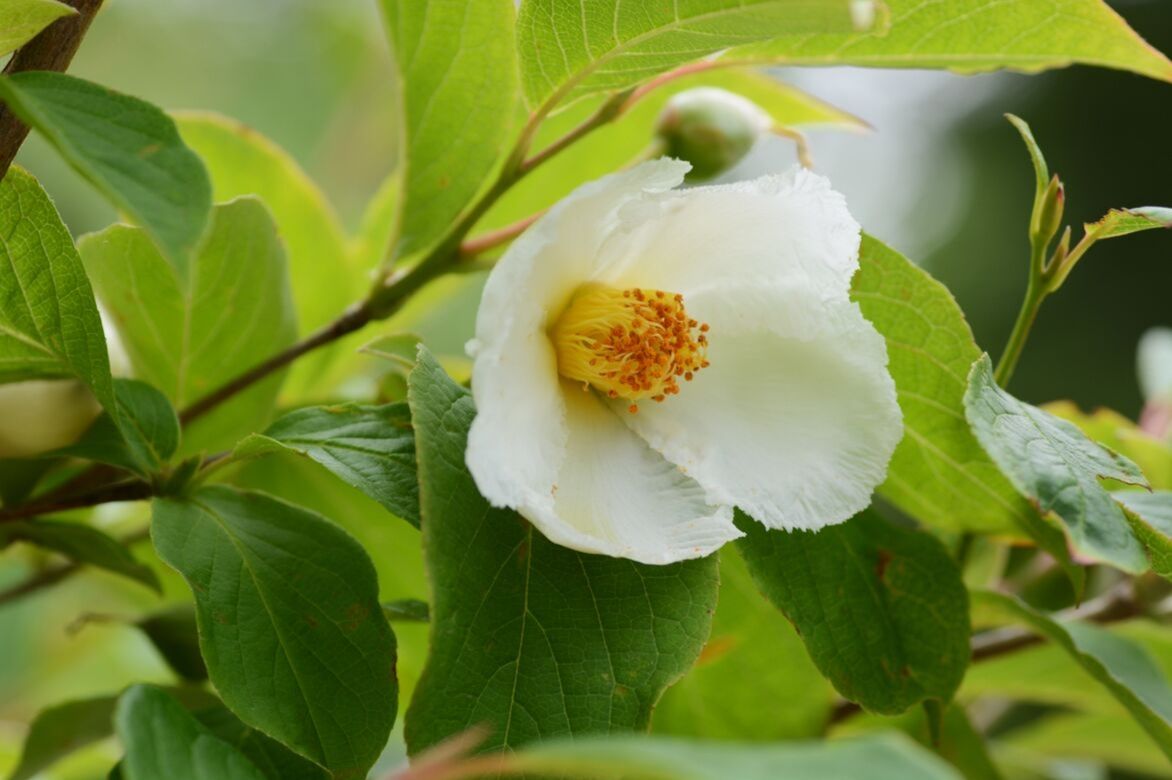




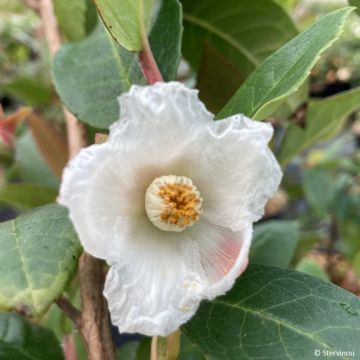

Comments